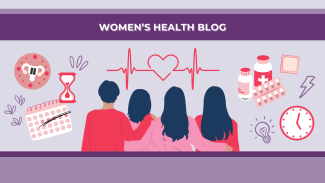Authors: Nabilah Gulamhusein, BSc, PhD Candidate, Libin Cardiovascular Institute
Cumming School of Medicine, University of Calgary | Editors: Romina Garcia de leon, Janielle Richards (Blog Coordinators) Expert reviewer: Alexandra Lukey
Published: Friday October 18th, 2024
Cardiovascular disease is an umbrella term used to describe a variety of conditions that affect the heart and blood vessels such as heart attack, coronary heart disease and stroke. Globally, cardiovascular disease is a leading cause of death among women, and elevated blood pressure or hypertension is one of the most common modifiable risk factors for cardiovascular mortality. Recognizing the importance of blood pressure control, the World Health Organization has set a global target of a 25% relative reduction in uncontrolled hypertension by 2025. Within Canada, the number of people living with hypertension has remained relatively steady between 2007 and 2017, however, the rates of awareness, treatment and control have worsened in women. Hence, there is an urgent need to identify factors across a female’s lifespan that may contribute to hypertension.
Menopause is a natural part of the ageing process and is marked by the cessation of menses for 12 consecutive months. The average age of menopause in Canada is 51 years. Menopause can be associated with a variety of symptoms including genitourinary symptoms, hot flashes, sleep disturbances and cognitive changes. Up to 75% of individuals will face debilitating vasomotor symptoms, such as night sweats and hot flashes, and can severely impact an individual’s quality of life; the average length for such symptoms is 7 years. According to the North American Menopause Society Position Statement, the first line of treatment for vasomotor symptoms is menopausal hormone therapy, for people without contraindications. Menopausal hormone therapy often consists of estrogen and progestins, which may be used individually or together to help treat symptoms of menopause.
Although it is estimated that by the year 2025, there will be more than a billion menopausal individuals on the planet, surprisingly little is known about menopausal hormone therapy and its relation to cardiovascular disease. Historically, menopausal hormone therapy was prescribed to women with the intent of providing cardiovascular protection, as seen in the Nurses’ Health Study. However, there has been a paradigm shift as a more recent randomized controlled trial showed no difference in coronary heart disease between people taking menopausal hormone therapy and those taking placebo. The discrepant findings continue to be debated in the literature and a variety of possible factors for the conflicting findings have come to light. For example, the timing at which menopausal hormone therapy is initiated, the dosage, route of administration and formulation may all play an important role in contributing to different study findings, though further research is required.
A part of my doctoral thesis aims to address this research gap. Previous studies have shown that individuals using transdermal estrogen have a significant decrease in blood pressure when compared to those taking a placebo. To further complement this observation, oral use of estrogen has been shown to be associated with higher systolic and diastolic blood pressures, and greater risk of hypertension. Despite these findings, studies have been limited in sample size and a mechanism for this has not yet been identified. Therefore, my research program aims to examine the relationship between the route of menopausal hormone therapy administration and blood pressure while elucidating a mechanism as to how this may occur.
Overall, this study will help us advance our knowledge about cardiovascular health in females, inform clinicians about optimal delivery for menopausal hormone therapy, and ultimately help empower females to make decisions about their own health and what is right for them.
